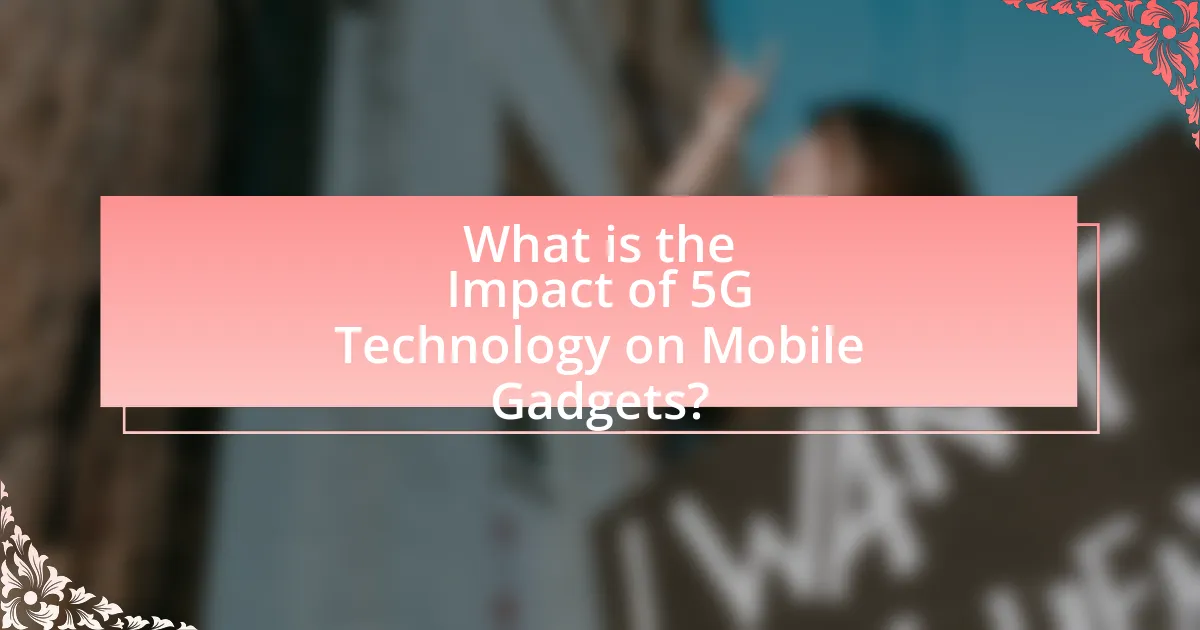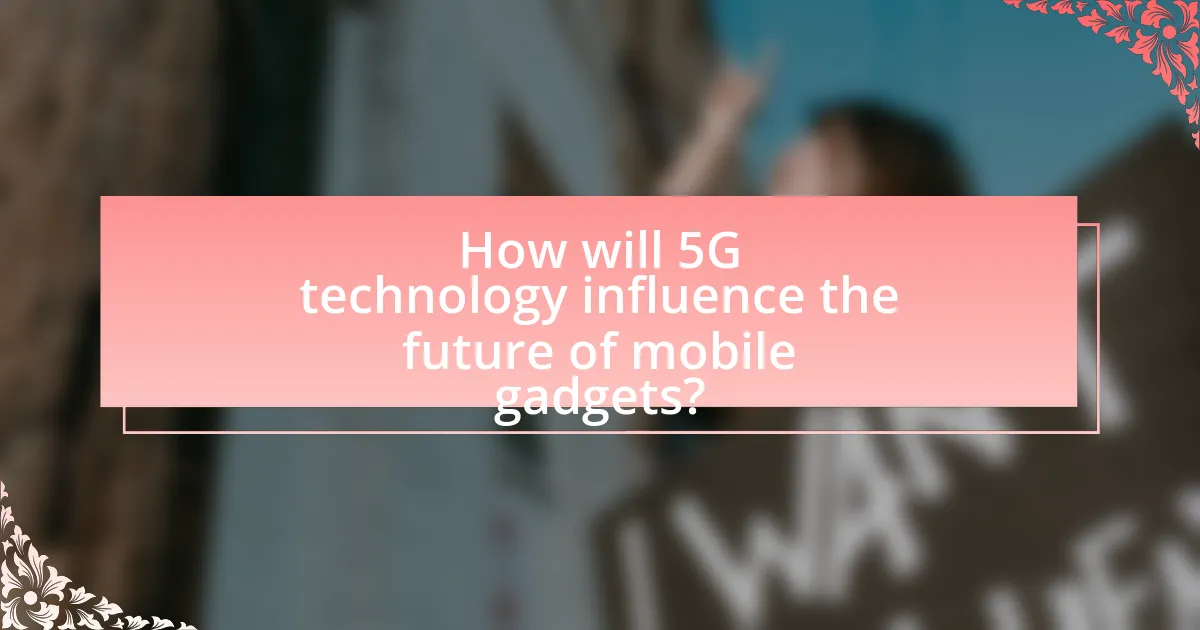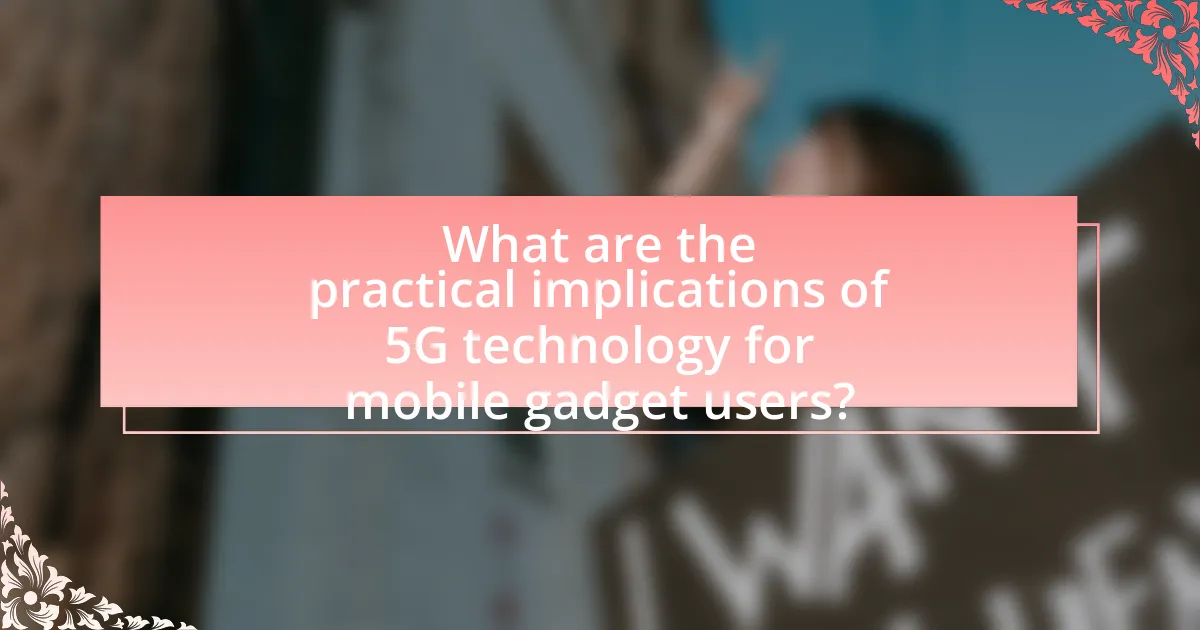5G technology represents a significant advancement in mobile connectivity, offering faster data speeds, lower latency, and improved capacity for connected devices. This article explores the impact of 5G on mobile gadgets, highlighting its ability to support high-bandwidth applications such as augmented reality and ultra-high-definition video streaming. Key features of 5G, including enhanced data transfer rates and real-time communication capabilities, are discussed, along with the challenges of compatibility and infrastructure requirements. Additionally, the article examines how 5G will influence mobile device design, user experience, and the future of mobile applications, ultimately transforming how users interact with technology.

What is the Impact of 5G Technology on Mobile Gadgets?
5G technology significantly enhances mobile gadgets by providing faster data speeds, lower latency, and improved connectivity. This advancement allows mobile devices to support high-bandwidth applications such as augmented reality, virtual reality, and ultra-high-definition video streaming. According to a report by the Global System for Mobile Communications (GSMA), 5G networks can achieve speeds up to 100 times faster than 4G, enabling seamless user experiences and the ability to connect more devices simultaneously. Additionally, the reduced latency of 5G, which can be as low as 1 millisecond, enhances real-time communication and responsiveness in applications, making mobile gadgets more efficient and versatile.
How does 5G technology differ from previous generations?
5G technology differs from previous generations primarily through its significantly higher data transfer speeds, lower latency, and increased capacity for connected devices. Specifically, 5G can achieve speeds up to 10 Gbps, which is up to 100 times faster than 4G LTE, allowing for rapid downloads and seamless streaming. Additionally, 5G reduces latency to as low as 1 millisecond, enhancing real-time communication and responsiveness in applications such as gaming and autonomous vehicles. Furthermore, 5G networks can support up to 1 million devices per square kilometer, compared to 4G’s capacity of around 100,000 devices, enabling the proliferation of Internet of Things (IoT) devices and smart technologies. These advancements position 5G as a transformative technology for mobile gadgets, facilitating new applications and services that were not feasible with earlier generations.
What are the key features of 5G technology?
The key features of 5G technology include enhanced data speeds, reduced latency, increased capacity, and improved connectivity. Enhanced data speeds can reach up to 10 Gbps, significantly faster than 4G, allowing for quicker downloads and smoother streaming. Reduced latency, often as low as 1 millisecond, enables real-time communication, which is crucial for applications like autonomous driving and remote surgery. Increased capacity supports a higher number of devices per square kilometer, facilitating the Internet of Things (IoT) expansion. Improved connectivity ensures more reliable connections in crowded areas, enhancing user experience in urban environments. These features collectively transform mobile gadgets, enabling advanced functionalities and applications.
How does 5G enhance mobile connectivity?
5G enhances mobile connectivity by providing significantly higher data transfer speeds, reduced latency, and increased capacity for connected devices. Specifically, 5G networks can achieve speeds up to 10 Gbps, which is up to 100 times faster than 4G, allowing for seamless streaming and quicker downloads. Additionally, 5G reduces latency to as low as 1 millisecond, enabling real-time communication and responsiveness in applications such as gaming and virtual reality. Furthermore, 5G can support up to 1 million devices per square kilometer, facilitating the growth of the Internet of Things (IoT) and smart city technologies. These advancements collectively improve user experience and enable new applications that were not feasible with previous generations of mobile technology.
What are the potential benefits of 5G for mobile gadgets?
5G technology offers significant benefits for mobile gadgets, primarily through enhanced speed, reduced latency, and increased connectivity. With download speeds potentially exceeding 10 Gbps, mobile gadgets can stream high-definition content seamlessly and download large files in seconds. The latency reduction to as low as 1 millisecond enables real-time applications, such as augmented reality and gaming, to function more effectively. Furthermore, 5G supports a higher density of connected devices, allowing mobile gadgets to operate efficiently in crowded environments, which is crucial for the Internet of Things (IoT) ecosystem. These advancements collectively enhance user experience and expand the capabilities of mobile gadgets.
How does 5G improve mobile internet speeds?
5G improves mobile internet speeds by utilizing higher frequency bands and advanced technologies such as Massive MIMO (Multiple Input Multiple Output) and beamforming. These enhancements allow for greater data transmission capacity and reduced latency, enabling download speeds that can exceed 10 Gbps under optimal conditions. According to a report by the International Telecommunication Union, 5G networks can achieve peak data rates that are up to 100 times faster than 4G LTE, significantly enhancing user experience for applications like streaming, gaming, and real-time communication.
What impact does 5G have on mobile device performance?
5G significantly enhances mobile device performance by providing faster data speeds, lower latency, and improved connectivity. Specifically, 5G networks can achieve download speeds exceeding 1 Gbps, which is up to 100 times faster than 4G, allowing for seamless streaming and quicker downloads. Additionally, 5G reduces latency to as low as 1 millisecond, enabling real-time applications such as gaming and augmented reality to function more effectively. The increased capacity of 5G networks also supports a higher number of connected devices simultaneously, improving overall user experience in densely populated areas.
What challenges does 5G technology present for mobile gadgets?
5G technology presents several challenges for mobile gadgets, primarily related to compatibility, battery consumption, and infrastructure requirements. Mobile gadgets must be equipped with new hardware to support 5G frequencies, which can lead to increased costs and potential obsolescence of existing devices. Additionally, 5G networks consume more power, resulting in faster battery drain for mobile gadgets, which can hinder user experience. Furthermore, the deployment of 5G requires extensive infrastructure upgrades, including more cell towers, which may not be uniformly available in all regions, limiting access to the technology. These challenges highlight the complexities involved in transitioning to 5G for mobile devices.
What are the compatibility issues with existing mobile devices?
Compatibility issues with existing mobile devices primarily stem from hardware limitations and software incompatibility with 5G technology. Many older devices lack the necessary hardware components, such as advanced antennas and chipsets, to support 5G networks, which can lead to reduced performance or inability to connect. For instance, devices designed for 4G LTE may not be able to utilize the higher speeds and lower latency offered by 5G, as they are not equipped to handle the new frequency bands and network protocols. Additionally, software updates may not be available for older models, further hindering their ability to connect to 5G networks. According to a report by the GSMA, approximately 40% of mobile devices in use globally as of 2021 are not 5G compatible, highlighting the widespread nature of this issue.
How does the rollout of 5G affect mobile gadget manufacturers?
The rollout of 5G significantly impacts mobile gadget manufacturers by driving the demand for new devices that can support enhanced connectivity features. As 5G technology offers faster data speeds, lower latency, and improved network reliability, manufacturers are compelled to innovate and produce smartphones, tablets, and other gadgets equipped with 5G capabilities. For instance, a report from the Global System for Mobile Communications (GSMA) indicates that by 2025, there will be over 1.7 billion 5G connections worldwide, prompting manufacturers to adapt their product lines to meet consumer expectations for high-performance devices. This shift not only influences design and functionality but also affects supply chains and production strategies as manufacturers seek to integrate advanced technologies such as improved antennas and chipsets to leverage the benefits of 5G.

How will 5G technology influence the future of mobile gadgets?
5G technology will significantly enhance the capabilities of mobile gadgets by providing faster data speeds, lower latency, and improved connectivity. This advancement allows mobile devices to support more complex applications, such as augmented reality and high-definition streaming, which require substantial bandwidth. According to a report by the GSMA, 5G networks are expected to deliver speeds up to 100 times faster than 4G, enabling seamless user experiences and the proliferation of IoT devices. Additionally, the reduced latency of 5G, estimated to be as low as 1 millisecond, will facilitate real-time communication and interactions, further transforming how users engage with mobile technology.
What new features can we expect in mobile gadgets with 5G?
Mobile gadgets with 5G will feature significantly enhanced data speeds, enabling faster downloads and smoother streaming. This improvement is due to 5G’s capability to provide speeds up to 10 Gbps, which is up to 100 times faster than 4G. Additionally, mobile devices will support advanced applications such as augmented reality (AR) and virtual reality (VR), which require high bandwidth and low latency for optimal performance. The low latency of 5G, around 1 millisecond, allows for real-time interactions in gaming and remote applications. Furthermore, 5G will facilitate improved connectivity for Internet of Things (IoT) devices, allowing for seamless integration and communication among various gadgets. These features collectively enhance user experience and expand the functionality of mobile devices in everyday life.
How will 5G enable advancements in mobile gaming?
5G will enable advancements in mobile gaming by providing significantly higher data speeds, lower latency, and increased connectivity. These improvements allow for real-time multiplayer experiences, seamless cloud gaming, and enhanced graphics quality. For instance, 5G networks can achieve speeds up to 10 Gbps, which is up to 100 times faster than 4G, facilitating smoother gameplay and quicker downloads. Additionally, the latency of 5G can be as low as 1 millisecond, compared to 30-50 milliseconds for 4G, which minimizes lag and enhances responsiveness in competitive gaming scenarios. This combination of speed and low latency supports more immersive and interactive gaming experiences, making mobile gaming more comparable to traditional console and PC gaming.
What role will 5G play in the development of augmented and virtual reality on mobile devices?
5G will significantly enhance the development of augmented and virtual reality (AR and VR) on mobile devices by providing faster data transfer speeds, lower latency, and increased network capacity. These improvements enable seamless streaming of high-quality AR and VR content, allowing for more immersive experiences. For instance, 5G networks can achieve speeds up to 10 Gbps, which is essential for rendering complex graphics in real-time. Additionally, the reduced latency of around 1 millisecond compared to 4G’s 30-50 milliseconds allows for instantaneous interactions within AR and VR environments, crucial for applications like gaming and remote collaboration. This technological advancement supports the growth of innovative applications, making AR and VR more accessible and practical for everyday use.
How will 5G technology impact mobile gadget design?
5G technology will significantly impact mobile gadget design by enabling faster data transfer rates and lower latency, which allows for more advanced features and functionalities. This advancement will lead to the integration of enhanced capabilities such as augmented reality, virtual reality, and high-definition streaming directly into mobile devices. Additionally, the need for improved battery efficiency and thermal management will drive design innovations, as devices will require more robust hardware to support the increased processing demands of 5G applications. As a result, manufacturers will focus on creating slimmer, lighter devices that can accommodate these technological advancements while maintaining user comfort and usability.
What changes in hardware are necessary for 5G compatibility?
To achieve 5G compatibility, mobile devices require significant hardware changes, including the integration of new chipsets that support 5G frequencies and standards. These chipsets must be capable of handling higher data rates and lower latency, which are essential features of 5G technology. Additionally, devices need advanced antennas, such as multiple-input multiple-output (MIMO) antennas, to improve signal reception and transmission. The transition to 5G also necessitates the inclusion of upgraded power management systems to efficiently handle the increased energy demands associated with faster data processing and connectivity.
How will user interface design evolve with 5G technology?
User interface design will evolve significantly with 5G technology by enabling more responsive, immersive, and data-rich experiences. The increased bandwidth and lower latency of 5G will allow designers to implement real-time interactions, high-definition graphics, and augmented reality features seamlessly. For instance, applications can leverage 5G’s capabilities to deliver instant feedback and updates, enhancing user engagement and satisfaction. Additionally, the ability to connect multiple devices simultaneously will lead to more integrated interfaces across platforms, fostering a cohesive user experience. This evolution is supported by industry reports indicating that 5G networks can achieve speeds up to 100 times faster than 4G, fundamentally transforming how users interact with mobile applications and devices.

What are the practical implications of 5G technology for mobile gadget users?
5G technology significantly enhances mobile gadget users’ experiences by providing faster data speeds, lower latency, and improved connectivity. With data speeds reaching up to 10 Gbps, users can download large files, stream high-definition content, and engage in real-time applications with minimal buffering. The latency reduction to as low as 1 millisecond enables smoother online gaming and augmented reality experiences. Additionally, 5G supports a higher density of connected devices, allowing users to connect multiple gadgets simultaneously without compromising performance. These advancements lead to more efficient use of mobile applications and services, ultimately transforming how users interact with technology in their daily lives.
How can users maximize the benefits of 5G technology on their mobile gadgets?
Users can maximize the benefits of 5G technology on their mobile gadgets by ensuring they have compatible devices, utilizing 5G networks in areas with strong coverage, and optimizing their settings for performance. Compatible devices, such as smartphones designed for 5G, can leverage faster download and upload speeds, which can be significantly higher than 4G, often exceeding 1 Gbps in optimal conditions. Utilizing 5G networks in areas with strong coverage is crucial, as the performance of 5G can vary greatly depending on location; for instance, urban areas typically have better infrastructure. Additionally, optimizing device settings, such as enabling 5G mode and managing background applications, can enhance performance and battery life, allowing users to fully experience the advantages of low latency and high-speed connectivity that 5G offers.
What tips should users consider when upgrading to a 5G device?
When upgrading to a 5G device, users should ensure that their location has 5G coverage, as network availability varies significantly. Research indicates that 5G networks are still being rolled out, and areas with limited coverage may not benefit from the technology. Users should also consider the compatibility of their current accessories, such as cases and chargers, as some may not fit newer models. Additionally, evaluating the device’s specifications, including battery life and processing power, is crucial since 5G can consume more energy and require more robust hardware. Finally, users should compare plans from different carriers to find the best data options, as 5G plans can differ in pricing and data limits.
How can users troubleshoot common issues related to 5G connectivity?
Users can troubleshoot common issues related to 5G connectivity by following a series of systematic steps. First, they should ensure that their device is 5G-capable and that they are in an area with 5G coverage, as many regions still have limited availability. Next, users should check their device settings to confirm that 5G is enabled, as it may be set to 4G or LTE by default.
If connectivity issues persist, restarting the device can resolve temporary glitches. Users should also verify that their mobile plan includes 5G access, as some plans may not support it. Additionally, checking for software updates on the device can ensure that it has the latest enhancements and bug fixes related to 5G performance.
If these steps do not resolve the issue, users can reset network settings, which can clear any misconfigurations affecting connectivity. Finally, contacting the mobile service provider can provide insights into network outages or specific account issues that may be impacting 5G access.

